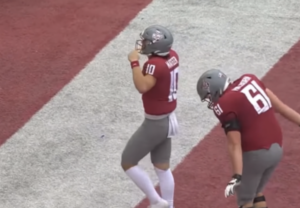PULLMAN, WASH. – March eighth was the mark of International Women’s Day, but some people on campus felt that this day needed to be celebrated just a little longer.
International Women’s Day lands at the beginning of Women’s History Month. This year’s theme is #BreakTheBias where people are asked to imagine a world free of gender biases, discrimination, stereotypes, and more.
The WSU Women’s Center teamed up with other organizations on campus to help bring awareness to this month and theme and spread a little joy this week.
One of those organizations was the Jordan Schnitzer Museum of Art which dedicated special tours of the exhibition Mirror Mirror: The Prints of Alison Saar in the museum, led by education coordinator Kristin Becker.
Mirror Mirror focuses on Saar’s struggles and biases she faced as a biracial American and the tour takes you through a few pieces that can be related to the #BreakTheBias theme.
“So the tours specifically are meant to draw attention to that. I mean, we can take this artist’s work and talk about many, many, many things, but it’s a great opportunity to focus on those issues in the last week that this show is up,” Becker said.
Alison Saar’s exhibition will only be up until this Saturday, but even though this art and the festivities are over doesn’t mean the sentiment of this month is.
Even when the flowers are put away, Becker said the conversations don’t need to be.
“Each person it’s different, everybody’s story is different and by starting this conversation, we hopefully hear from a number of individuals how they feel, what their situation is,” Becker said.
Jackelyn Sedano, the program coordinator of the WSU Women’s Center stressed the idea that you don’t have to be restricted to just one month to celebrate people.
“But I think sometimes it gives people the idea that okay this is the only time that we celebrate women and we’re done,” Sedano said.
To keep the momentum of Women’s History Month going the rest of the year, Sedano said you don’t need to have art exhibitions or pass out flowers to the public.
“And it can look a bunch of different ways. Maybe you donate to a women’s organization. maybe you yourself read some books about women’s history, maybe you read some books just by women authors in general,” Sedano said.


